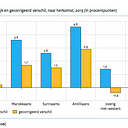Normen van de European Commission against Racism and Intolerance (Raad van Europa)
“a considerable amount of information is available in the Netherlands broken down by “allochthony” — “allochthonous” persons [. . .] However, the extent to which this information is used to inform policy aimed at improving the situation of those persons who are found to be at particular disadvantage is not clear to ECRI, especially as social policies in recent years have been targeted less and less at specific ethnic minority groups. Instead, it has been stressed that such information is rather used to target security measures at particular minority groups. [. . .] ECRI stresses the need for such data to be used to monitor patterns of discrimination or situations of disadvantage facing minority groups. It should not be used for purposes that contribute to further stigmatising the members of such groups”. European Commission against Racism and Intolerance (ECRI), Third report on the Netherlands, adopted on 29 June 2007, p.31–32.
“ “stigmatisation” shall mean the labelling of a group of persons in a negative way”. European Commission against Racism and Intolerance (ECRI), General policy recommendation no. 15 on combating hate speech, 8 December 2015, p. 16.
“ECRI recalls that the collection of data in different areas of life broken down according to categories such as national or ethnic origin is legitimate if it is done to monitor patterns of discrimination or situations of disadvantage facing vulnerable groups, provided that it is carried out with due respect to the principles of confidentiality, informed consent and the voluntary self-identification of persons as belonging to a particular group. Any other type of ethnic registration would be dangerous, contrary to human rights and prone to misuse”. European Commission against Racism and Intolerance (ECRI), Fourth report on the Netherlands, adopted on 20 June 2013, p.50–51.
“Cases in which persecution has relied on statistical files compiled for other purposes, or for that very purpose, are sufficiently well documented to remove all doubt as to their having occurred. Illicit uses include 1) identification of individuals with reference to characteristics which may expose them to discrimination, exclusion or even persecution 2) the use of statistics to stigmatise a vulnerable group. In the first case, the main dangers inherent in the collection of data and creation of files relate to the possibility of their being used to identify individuals. The data protection laws which regulate the collection, production and dissemination of personal data attempt to control and minimise those dangers. In the second, the problem is less the possibility of identifying individuals, than the isolation of variables which characterise individuals or groups. Here misuse takes the form of stigmatisation, e.g, when stereotypes are confirmed by using findings reductively, or publishing tables without explaining them or analysing the factors which account for discrepancies. This is particularly true of statistics on crime, the prevalence of behaviour regarded as deviant or social problems treated more as burden on the community than as disadvantage for those directly concerned”. Patrick Simon, ‘Ethnic statistics and data protection in the Council of Europe countries’, European Commission against Racism and Intolerance (ECRI), Council of Europe, Strasbourg, October 2007, p.14.
